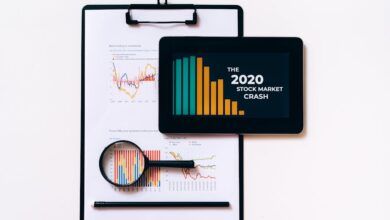Weathering the Economic Storm: Understanding Recession Indicators, Impacts, and Strategies for Survival

As economies around the world experience cycles of growth and contraction, understanding the early warning signs of a recession becomes increasingly vital for individuals, businesses, and policymakers alike. Recessions can have far-reaching impacts, affecting various sectors differently and prompting changes in consumer behavior, investment strategies, and global trade dynamics. This article delves into the multifaceted nature of economic downturns, exploring how they manifest, the strategies that can help investors navigate turbulent waters, and the role of government stimulus in fostering recovery. By examining lessons learned from past recessions and their relevance in today's economic landscape, we aim to equip readers with the knowledge and tools necessary to prepare for and survive potential downturns. Join us as we unpack the complexities of recessions and offer insights into building resilience in an ever-evolving economic environment.
- 1. **Recognizing the Signs: Early Indicators of an Economic Downturn**
- 2. **Navigating the Storm: Investment Strategies for Recession Resilience**
- 3. **Government Intervention: The Crucial Role of Stimulus in Economic Recovery**
1. **Recognizing the Signs: Early Indicators of an Economic Downturn**
Economic downturns often give early warning signs that can help individuals and businesses prepare for the challenges ahead. Recognizing these indicators is crucial for mitigating potential losses and making informed decisions.
One of the most common early signs of a recession is a decline in consumer confidence. When consumers feel uncertain about their financial future, they tend to reduce spending, leading to decreased demand for goods and services. This shift can be tracked through consumer sentiment surveys and retail sales data.
Another indicator is the behavior of leading economic indicators, such as stock market performance, housing starts, and manufacturing activity. A sustained drop in stock prices may signal investor concern about future corporate earnings, while a slowdown in housing starts can indicate a waning demand for new homes, reflecting broader economic uncertainty.
Job market trends also provide critical insights. An increase in unemployment claims or a slowdown in job creation can suggest that businesses are beginning to cut back on hiring or downsizing, often in anticipation of reduced consumer spending. Additionally, a decrease in wage growth can further dampen consumer confidence and spending.
Interest rates set by central banks can also offer clues. If the central bank lowers interest rates in response to economic concerns, it may signal an effort to stimulate the economy. Conversely, rising rates might indicate attempts to curb inflation, which could lead to reduced spending and an economic slowdown.
Finally, watching for changes in inflation rates can be revealing. While moderate inflation can be a sign of a growing economy, rapidly rising prices can erode purchasing power and lead consumers to tighten their budgets, potentially triggering a recession.
By staying alert to these early warning signs, individuals and businesses can take proactive measures to navigate the challenges of an impending economic downturn.
2. **Navigating the Storm: Investment Strategies for Recession Resilience**
During a recession, investors often face heightened uncertainty and volatility in the financial markets. However, with careful planning and strategic adjustments, it is possible to navigate these challenging economic times effectively. Here are several investment strategies that can enhance resilience during a recession.
First, diversifying a portfolio is crucial. By spreading investments across various asset classes, such as stocks, bonds, and commodities, investors can mitigate risk. Defensive sectors, such as utilities, healthcare, and consumer staples, often perform better during downturns as they provide essential goods and services that consumers continue to purchase, regardless of economic conditions.
Another important strategy is to focus on high-quality investments. Companies with strong balance sheets, stable earnings, and consistent cash flow tend to weather economic storms more effectively than their less secure counterparts. Investing in dividend-paying stocks can also provide a reliable income stream, as these companies are often more resilient and committed to returning value to shareholders.
Additionally, considering fixed-income investments, such as government bonds, can be a safer choice during a recession. These assets typically offer lower risk and can provide stability in a portfolio when equity markets are under pressure. Moreover, bonds can serve as a hedge against market volatility.
Investors should also maintain a cash reserve. Having liquidity allows for flexibility and the opportunity to capitalize on undervalued assets as prices decline. This strategy can be particularly advantageous for those looking to buy into strong companies at discounted valuations during a recession.
Lastly, it is essential to remain informed and adaptable. Market conditions can change rapidly, and being aware of economic indicators can help investors make timely decisions. Engaging with financial advisors or utilizing market research can provide valuable insights and guidance.
By employing these strategies, investors can enhance their resilience during economic downturns, positioning themselves to recover and thrive when the economy eventually rebounds.
3. **Government Intervention: The Crucial Role of Stimulus in Economic Recovery**
Government intervention plays a pivotal role in mitigating the effects of economic recessions, with stimulus measures serving as a crucial tool for recovery. When economic activity slows, businesses may cut back on production, leading to layoffs and reduced consumer spending. In such scenarios, government stimulus can help to counteract these negative trends by injecting capital into the economy, thereby supporting both businesses and households.
Stimulus packages often take the form of direct cash payments to individuals, expanded unemployment benefits, or tax cuts, which aim to boost consumer spending. Increased consumer demand can help stimulate production, encouraging businesses to retain or hire employees, which in turn fosters economic growth. Additionally, government investment in infrastructure projects can create jobs and stimulate various sectors, leading to a more robust recovery.
Furthermore, stimulus measures can also focus on sectors most affected by the recession, providing targeted support to industries such as travel, hospitality, and retail. This targeted approach helps maintain critical supply chains and ensures that essential services remain operational during downturns.
Historical evidence underscores the effectiveness of government stimulus in promoting recovery. For example, during the Great Recession of 2008-2009, the U.S. implemented the American Recovery and Reinvestment Act, which contributed to a significant rebound in economic activity. Similarly, during the COVID-19 pandemic, various countries introduced unprecedented stimulus measures that helped avert deeper economic crises.
While the immediate effects of stimulus can be beneficial, it is essential to consider potential long-term implications, such as increased national debt or inflation. Nevertheless, when executed effectively, government intervention through stimulus can be a vital element in stabilizing the economy and fostering recovery during challenging times.
In conclusion, understanding the early warning signs of an economic recession is crucial for individuals, businesses, and policymakers alike. By recognizing these indicators, stakeholders can better prepare for the potential impacts on various sectors, from consumer goods to global trade. During downturns, investment strategies that emphasize resilience can help mitigate losses and capitalize on unique opportunities. Moreover, government stimulus plays a vital role in cushioning the blow of economic contractions, highlighting the importance of timely and effective policy responses.
As consumer behavior shifts during recessions, businesses must adapt their strategies to meet changing demands and preferences. Learning from past recessions provides valuable insights into effective preparation and survival tactics, ensuring that organizations are equipped to navigate future economic uncertainties. Ultimately, while recessions present significant challenges, they also offer lessons and opportunities for growth, underscoring the importance of vigilance, adaptability, and strategic planning in fostering economic resilience.





